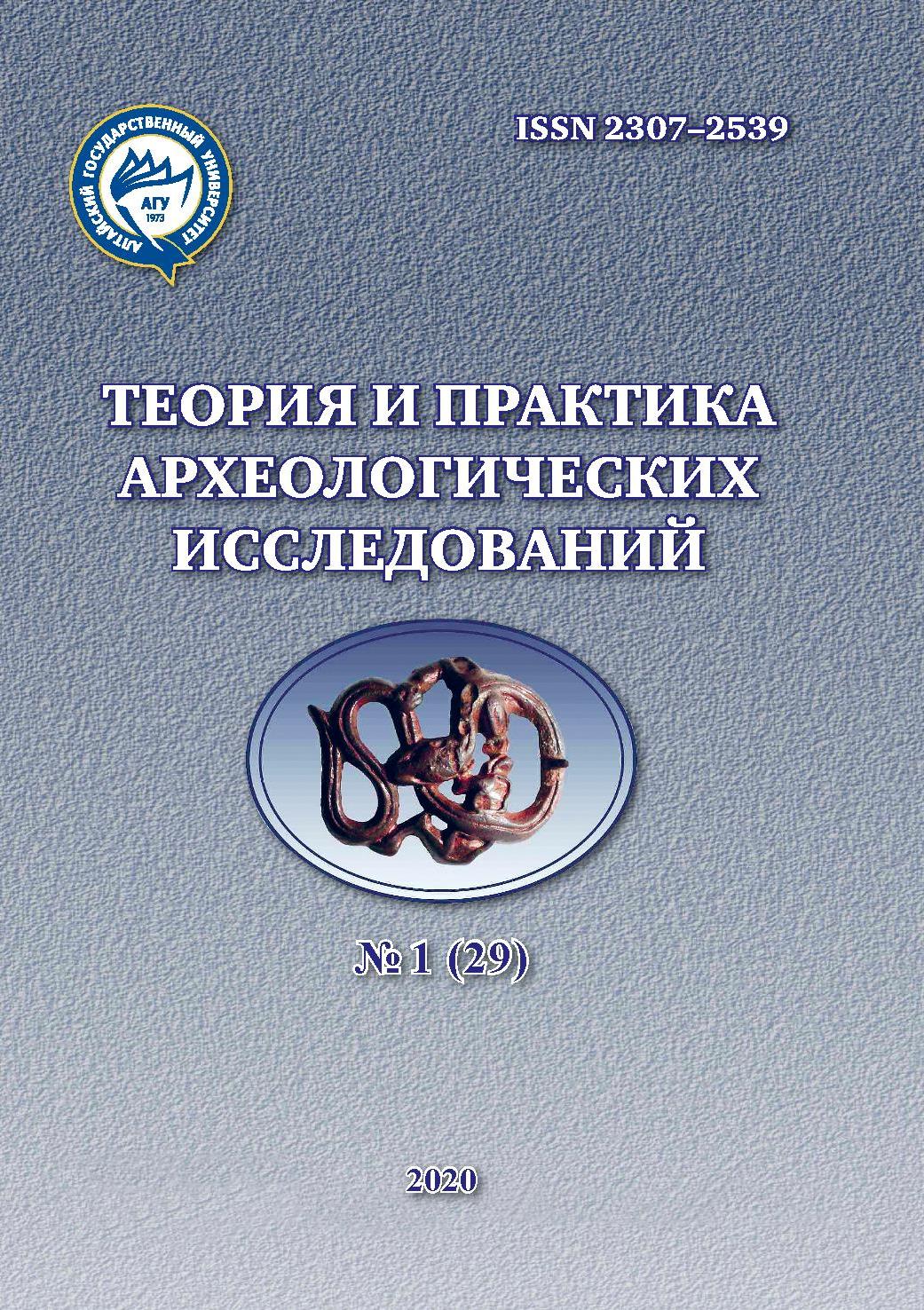МЕГАЛИТИЧЕСКИЕ КОМПЛЕКСЫ ТРОПИЧЕСКОЙ ЧАСТИ ТИХООКЕАНСКОГО БАССЕЙНА: ИНДОНЕЗИЯ
Abstract
Мегалиты и мегалитические комплексы зафиксированы практически во всех странах Юго-Восточной Азии как в континентальной, так и в островной частях, включая территорию Индонезии. Первые сведения о мегалитах и их описания появляются еще в период «колониальной археологии» (2-я половина XIX – середина XX в.) в публикациях европейских (в первую очередь голландских) и североамериканских ученых, миссионеров и представителей колониальной администрации (А. Стейнмец, А. Крюйт, В. Каудерн, Я. ван дер Хууп, У. Перри и др.). Интересным примером разнообразия конструкций и полифункционального назначения мегалитических сооружений являются памятники в провинции Западная Ява (остров Ява): ярусный комплекс Гунунг-Паданг, ступенчатая пирамида Панггуянган и комплекс с менгирами Тугу-Геде, время сооружения которых определяется в широком диапазоне от финала неолита (2500 л.н.) до средневековья (VII–XVI вв. н.э.). Анализ мегалитических памятников на территории Индонезии позволяет не только проследить их региональные особенности, но и добавить новые аспекты в общую дискуссию о проявлении мегалитизма и монументальности в древних обществах.
Downloads
Metrics
No metrics found.
References
Markovin V.I. Megality Zapadnogo Kavkaza [Megalithis of Western Caucasian]. M. : Nauka, 1978. 328 p.
Marsadolov L.S. Sakral’naya arheologiya i klassifikaciya megalitov [Sacred Archaeology and Classification of the Megaliths]. Teoriya i praktika arheologicheskih issledovanij [Theory and Practice of Archaeological Researches]. 2016. №3. Pp. 44–62.
Nesterkina A.L. Megality na territorii Rossii i problema vzaimosvyazej s sopredel’nymi territoriyami [Megaliths on the Territory of Russia and the Problems of the Connection with the Neighboring Territories]. Arheologiya Evrazii i Korejskogo poluostrova [Archaeology of Eurasia and Korean Peninsula]. Ceul : Institut arheologii i drevnej istorii Korei pri Universitete Kyonhi, 2018. Pp.15–32. [na russ. i kor. yaz.].
Nesterkina A.L., Solov’eva E.A., Tabarev A.V., Ivanova D.A. Megaliticheskie sooruzheniya Korejskogo poluostrova i Yaponskogo arhipelaga: kompleksnyj analiz problem proiskhozhdenya i naznacheniya [Megalithic Constructions of Korean Peninsula and Japanese Archipelago: Complex Analysis of the Problems of Origin and Function]. Arheologiya, etnografiya, antropologiya Evrazii [Archaeology, Ethnography, Anthropology of Eurasia]. 2017. V. 43, №3. Pp. 106–114.
Serikov Yu.B. Kul’tovye kamni i megaliticheskie sooruzheniya Urala [Cult Stones and Megalithic Constructions of Ural Mountans]. Ezhegodnik finno-ugorskih issledovanij [Yearbook of Finnish-Ugrian Researches]. 2018. V. 12, Iss. 1. Pp. 8–97.
Stanуukovich M.V. Neobychnaya biografiya (Roj Frenklin Barton, 1883–1947) [Unusual Biography (Roy Franklin Barton, 1883-1947)]. Sovetskaya etnografiya [Soviet Ethnography]. 1979. №1. Pp. 76–83.
Sysoeva S.V. Pro ostrov Sumbu, ten’ ot nebesnyh korablej, kamennye sarkofagi i vosem’ par Marapu [About the Sumba Island, Shadow of Sky Boats, Stone Sarcophagi, and Eight Couples of Marapu]. Vostochnaya kollekciya [Eastern Collection]. 2011. №4. Pp. 66–77.
Tabarev A.V. Voznagrazhdenie vechnost’yu: osobennosti pogrebal’noj praktiki v drevnih kul’turah tihookeanskogo bassejna na rubezhe er [Prized with the Eternity: Peculiarities of the Burial Practices in the Ancient Cultures of the Pacific Basin on the Edge of Eras]. Vestnik RFFI [RFBR Newsletters]. Gumanitarnye i obshchestvennye nauki. 2018. №2. Pp. 37–47.
Tabarev A.V., Gavrilina T.A., Patrusheva A.E., Serovec G.V. Pionery tihookeanskoj arheologii [Pioneers of Paific Archaeology]. Gumanitarnye issledovaniya v Vostochnoj Sibiri i na Dal’nem Vostoke [Humanitarian Researches in Eastern Siberia and Far East]. 2019. 2. Pp. 21–31.
Tabarev A.V., Ivanova D.A., Nesterkina A.L., Solov’eva E.A. Dzyomonskaya tradiciya monumental’nyh sooruzhenij na Yaponskom arhipelage: istoki, osobennosti, rasprostranenie [Jomon Megalithic Tradition on the Japanese Archipelago: Roots, Peculiarities, Distribution]. Arheologiya, etnografiya i antropologiya Evrazii [Archaeology, Ethnography, Anthropology of Eurasia]. 2017. V. 54, №4. Pp. 45–55.
Cheboksarov N.N. Sorok dnej v Indonezii [Forty Days in Indonesia]. Vestnik Akademii nauk SSSR [Bulletin of USSR Academy of Sciences]. 1962. №10. Pp.78–83.
Adams R. Transforming Stone. Ethnoarchaeological Perspectives on Megalith Form in Eastern Indonesia. Megalithic Quarrying. Sourcing, Extracting and Manipulating the Stones. Proceedings of the XV UISPP World Congress (Lisbon, 4–9 September, 2006). Oxford : Archaeopress. BAR International Series. 2009. Nо. 1923.
Archaeology: Indonesian Perspective: R.P. Soejono’s festschrift. Menteng, Jakarta : Indonesian Institute of Sciences, 2006. 618 p.
Bloembergen M., Eickhoff M. The Politics of Heritage in Indonesia: A Cultural History. Cambridge : Cambridge University Press, 2020. 338 p.
Boulestin B. Qu’est-ce que le mégalithisme? Mégalithismes vivants et passés: approches croisées. Oxford : Archaeopress, 2016. P. 57–94.
Cabral M.P., Saldanha J. Um Sítio Multiplas Interpretações: o caso do “Stonehenge do Amapá”. Revista de Arqueologia. 2009. V. 22, № 2. P. 115–123.
Cole S. Appropriated Meanings: Megaliths and Tourism in Eastern Indonesia. Indonesia and the Malay World. 2003. V. 31. P. 140–150.
Criado F. We, the Post-Megalithic People… The Meanings of Things, Material Culture and Symbolic Expression. One World Archaeology Series. 1989. V. 6. P. 79–89.
Harrisson T. Megalithic Evidences in East Malaysia: an Introductory Summary. Journal of the Malaysian Branch of the Royal Asiatic Society. 1973. V. 46, № 1. P. 123–139.
Heekeren H. The Bronze-Iron Age of Indonesia. Verhandelingen van het Koninklijk Instituut voor Taal-, Land- en Volkenkunde. 1958. Vol. 21.
Heine-Geldern R. Die Megalithen Südostasiens und ihre Bedeutung für die Klärung der Megalithenfrage in Europa und Polynesien. Anthropos. 1928. V. XXIII. P. 276–315.
Heine-Geldern R. Prehistoric Research in Indonesia.A nnual Bibliography of IndianA rchaeology. 1936. P. 26–38.
Kaudern W. Megalithic Finds in Central Celebes. Ethnographical Studies in Celebes: Results of the Author’s Expedition to Celebes 1917–20. V. 5. Göteborg : Elanders Boktryckeri Aktiebolag, 1938.
Keith H.G. Megalithic Remains in North Borneo. Journal of the Malayan Branch of the Royal Asiatic Society. 1947. V. 20, № 1. P. 153–155.
Kirleis W., Müller J., Kortemeier C., Behling H., Soeghondo S. The Megalithic Landscape of Central Sulawesi, Indonesia: Combining Archaeological and Palynological Investigations. Crossing Borders in Southeast Asian Archaeology. Selected Papers from the 13th International Conference of the European Association of Southeast Asian Archaeologists, Berlin, 2010. Singapore : NUS Press, 2012. P. 199–218.
Krom N.J. Voorloopige lijst van Oudheden in de Buitenbezittingen. OV, Bijlage T. Westenek, 1914. 81 p.
Kruyt A. L’immigration prehistorique dans Le pays des Toradjas occidentaux. Hommage du Service Archeologique des Indes Neerlandaises au Premier Congres des Prehistoriens d’Extreme-Orient. II, 1932. P. 1–15.
Loofs H.E.H. Elements of the Megalith Complex in South-East Asia. Oriental Monograph Series. 1967. №3.
McKinnon E.E. A Note of Finds of Early Chinese Ceramics Associated with Megalithic Remains in Northwest Lampung. Journal of Southeast Asian Studies. 1993. V. 24, No. 2. P. 227–238.
Miksic J. A Valley of Megaliths in West Sumatra; Mahat (Schnitger’s Aoer Doeri) revisited. Journal of the Malayan Branch of the Royal Asiatic Society. 1986. V. 59. P. 27–32.
Perry W. The Megalithic Culture of Indonesia. Manchester and London: University Press, 1918. 198 p.
Ramadina S.P. Analisis Perupaan Situs Megalitik Gunung Padang di Cianjur, Jawa Barat. Journal of Visual Art and Design. 2013. V. 4, No. 1. P. 51–66.
Raven H. C. The Stone Images and Vats of Central Celebes. Natural History. 1926. V. 26. P. 272–82.
Sarasin P., Sarasin F. Reisen in Celebes. Wiesbaden: S.W. Kriedel’s Verlag, 1905. 772 p.
Schmidt K. Göbekli Tepe – the Stone Age Sanctuaries. New results of ongoing excavations with a special focus on sculptures and high relief. Documenta Praehistorica. 2010. V. XXXVII. P. 239–256.
Soejono R.P. The History of Prehistoric Research in Indonesia to 1950. Asian Perspectives. 1969. V. XII. P. 69–92.
Steimer-Herbet T. Indonesian Megaliths: A Forgotten Cultural Heritage. Oxford : Archaeopress Archaeology, 2018. 104 p.
Steimer-Herbet T., Besse M. Indonesian Megaliths as the Result of the Interaction between Indigenous Peoples and Hindu-Buddhist Kingdoms. Austronesian Diaspora. A New Perspective. Proceedings of the International Symposium on Austronesian Diaspora (18th – 23rd July 2016, Nusa Dua, Bali, Indonésie). Gadjah Mada University Press, 2017. P. 301–318.
Trinh Nang Chung. Megalithic Relics of Vietnam: Discoveries and Studies. Bulletin of Miho Museum. 2018. V. XVIII, No. 3. P. 87–96.
Van der Hoop J.: Megalithic Remains in South-Sumatra. Bulletin de l’Ecole française d’Extrême- Orient. 1932. T. 32. P. 573–576.
Wagner F.A. Indonesia: The Art of an Island Group. London: Methuen, 1959. 256 p. Yondri L., Hum M. Situs Gunung Padang: kebudayaan, manusia, dan lingkungan. CV. Semiotika, 2017. 382 p.
Theory and Practice of Archaeological Research is a golden publisher, as we allow self-archiving, but most importantly we are fully transparent about your rights.
Authors may present and discuss their findings ahead of publication: at biological or scientific conferences, on preprint servers, in public databases, and in blogs, wikis, tweets, and other informal communication channels.
Theory and Practice of Archaeological Research allows authors to deposit manuscripts (currently under review or those for intended submission to ABS) in non-commercial, pre-print servers such as ArXiv.
Authors who publish with this journal agree to the following terms:
- Authors retain copyright and grant the journal right of first publication with the work simultaneously licensed under a Creative Commons Attribution License (CC BY 4.0) that allows others to share the work with an acknowledgement of the work's authorship and initial publication in this journal.
- Authors are able to enter into separate, additional contractual arrangements for the non-exclusive distribution of the journal's published version of the work (e.g., post it to an institutional repository or publish it in a book), with an acknowledgement of its initial publication in this journal.
- Authors are permitted and encouraged to post their work online (e.g., in institutional repositories or on their website) prior to and during the submission process, as it can lead to productive exchanges, as well as earlier and greater citation of published work (See The Effect of Open Access).








2.jpg)




